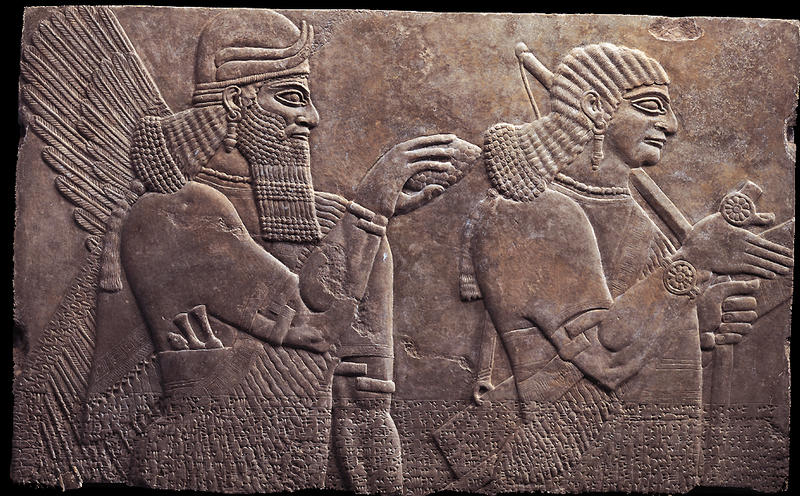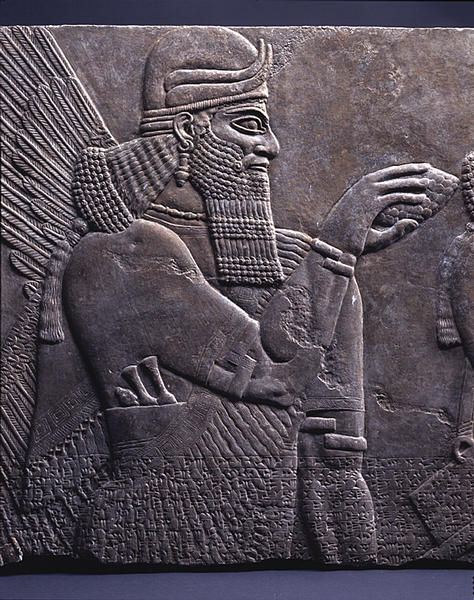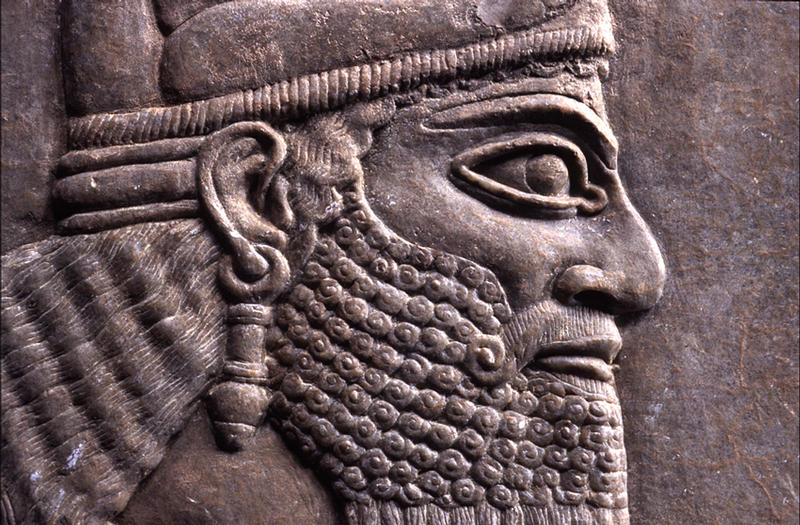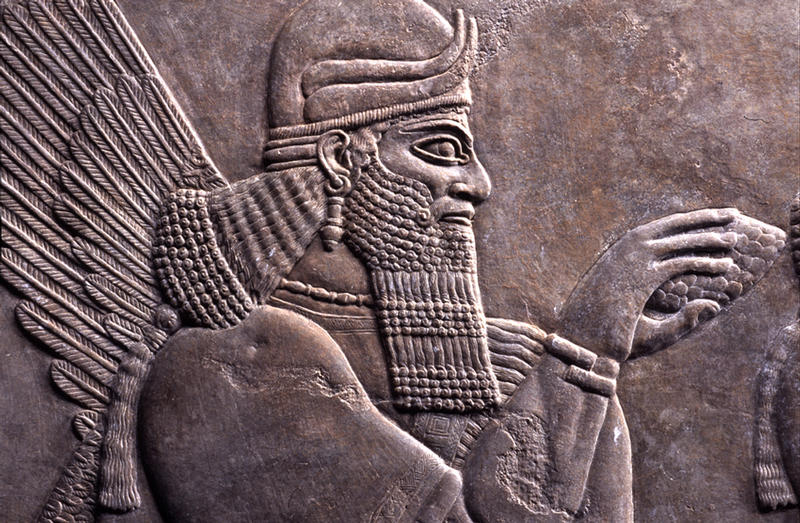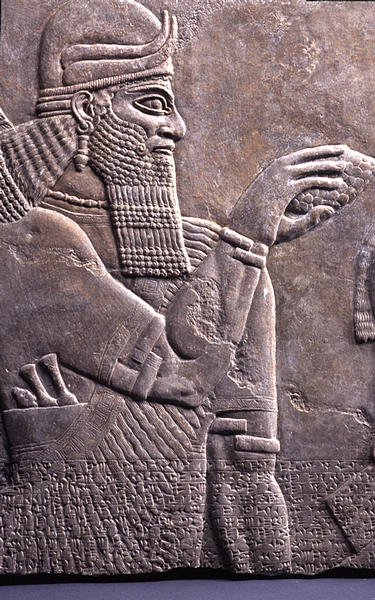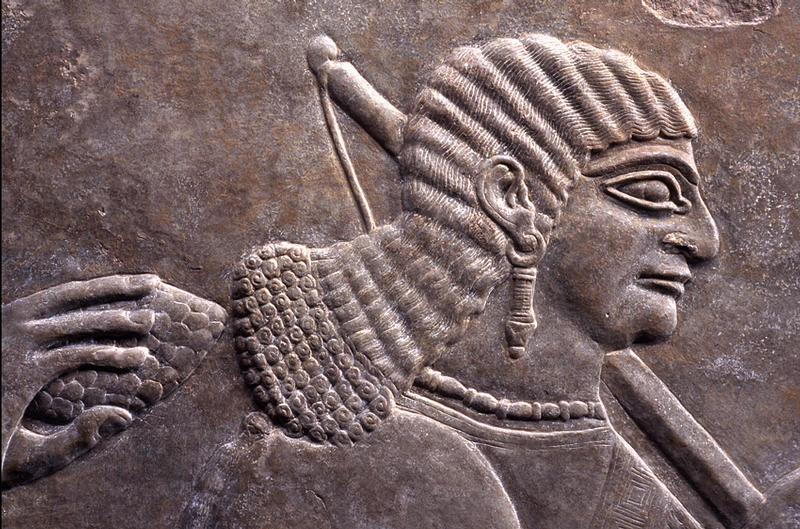精霊と従者浮彫
- イラク東北部 ニムルド北西宮殿
- 新アッシリア
- 前883-前859年
- 石灰岩
- H-110.5 D-10 W-183
この浮彫はアッシュールナシルパル二世の北西宮殿の壁面を飾ったもので、有翼精霊が王の後ろに控える従者の背後で浄めの仕草をしている。これは王の狩猟の仕舞の場面の一部であり、狩猟者、最高聖職者、統治者を「演じる」神と人間との間をつなぐ者ー王としてのすべての行いが、神の祝福のもとにあることを示しているかのように思われる。
浮彫の表現するもの
紀元前二千年紀の終わり頃から一千年紀初頭にはメソポタミアのアッシリア帝国が隆盛となり、周辺の地域に進出して行きました。
アッシュールナジルパル二世(883-859BC)はニムルド(古代のカルフ)を新しい都と定め、うず高い砦址の基盤の上に宮殿を造り、その壁に王の事績を描き記述した浮彫を施しました。
この都の建設には多くの周辺地域からの捕囚も従事し、紀元前879年に盛大な完成式典が行われました。メソポタミアでは、人間は神に仕えるために創られたものであるとするシュメール以来の伝統が継承され、王権も天から降されたもの、王は神と人間との間をつなぐものとされましたが、これらの浮彫は言わば「神の子」として、最高聖職者、為政者、狩猟者を演じる王の所業を描いているのです。
このレリーフはこの王の建てたニムルドの北西宮殿の玉座の間前室(C室)に由来するものと伝えられ、王の狩猟の最後の場面であると言われています。狩猟の最後に王は獲物に灌奠を行い、神に捧げるのですが、狩猟自体神聖な儀式でありそれに与かる者はすべて浄められねばならなかったのです。
髭の無い右側の人物は王の従者であり、王の行う儀式を最も間近で補佐しています。その左側即ち従者のすぐ後ろには二重の牛角の冠をつけ髭を生やした有翼の精霊が毬果を右手に持ち、浄めの所作を行っています。この精霊は通常右手に毬果、左手にシトゥラを持った姿に描かれていますが、この仕草で王や従者の他に生命の樹に向かっている姿もあります。
この浮彫にあらわされた衣装の縁飾の縫い取り、矢入、装身具の意匠などは、大変浅く線彫りされていますが、他の浮彫にも共通して言えることは、しばしばそこに表された場面構成や個々の図像要素には何らかの誤解か恣意に基づくと思われる改変がなされていることがあり、また基調の浮彫の厳格な作行きに対し、おおらかな雰囲気が感じられます。
これはこの制作に携わった職人がその刻む部分によってかなり相違する意識を持っていた事を示し、アッシリアの捕囚となった職人の手になるものではないかと考えられています。事実いくつかのレリーフにはマルリクの金属器に代表される北イラン、カスピ海南岸地方の意匠から由来すると思われる要素を垣間見ることができます。
Catalogue Entry
This is a portion of a scene that was originally a wall relief carved over three stone slabs depicting the King of Assyria, Ashurnasirpal II, flanked by his attendants and protective, divine figures. The scene once decorated the wall of an anteroom, Room C, at the west end of the throne room suite of the so-called Northwest Palace, the king's royal residence on the citadel mound of his capital city at Kalhu (Nimrud), near the Tigris River, in what is today northeastern Iraq. The scene was partially visible to the enthroned king through a wide doorway flanked by human-headed, winged lions (aladlammu) (fig. 1).1 The Shumei fragment shows a winged , human-headed genius (apkallu) on the left and a royal attendant on the right; they originally stood behind an image of the king.
The scene is preserved only in fragments, but the motif was described by Austen Henry Layard, the original excavator of the palace from 1848 to 1851; the details and fragments of the scene that survive were identified by scholars who have since worked on the reconstruction of the throne room suite (fig. 2).2
The king faced to the right and was carved on a single slab. In his left hand he held his bow erect, one end firmly set on the ground. In his right hand he raised an offering bowl up to the level of his face, as if to pour a libation. On the reliefs in the throne rooms, the king is depicted thus in a ritual at the close of the lion and bull hunts.3
To the right of the king on the adjacent slab was a royal attendant, a sword belted at his waist, holding a mace and a fly whisk. Behind the attendant, to his right, stood a winged, human-headed genius carrying a bucket and cone. The genius wears a miter with horns which, with his wings, signifies divinity. On the adjacent slab to the left of the king was another royal attendant carrying a mace and a bow, his quiver slung over his shoulder and a sword belted around his waist. Behind this figure was another winged, human-headed genius carrying the bucket and cone and wearing a horned mitre. These last two figures are the ones on the Shumei relief.
The king is dressed in a long tunic over which is draped a full-length body shawl, one corner slung over his shoulder. The attendants wear long tunics and what appears to be a short shawl draped over one shoulder. The geniuses wear short tunics and long body shawls, left open to show powerful musculature. All wear sandals. Preserved garment hems are decorated with a motif of squares within squares, edged with crisscross piping, and fringed. The bottom of the attendants' wide belt is similarly marked (perhaps incorrectly). This square-within-square decoration of the hems is the preferred garment decoration on all the other known reliefs from Room C. The figures' armlets and bracelets are either plain or are decorated with rosettes, the ends capped with finials etched with crisscrossed decoration. Each of the figures also wears a single or double strand of beads around his neck. Each of the geniuses and the king carry two knives and a whetstone in his wide belt. In Room C, geniuses to the left of the king all have two-horned miters; those to the right of the king have three-horned miters;4 our relief is from the left of the king and therefore the genius wears a two-horned miter. This variation suggests that there were at least two artists responsible for the iconography in this room. The figures' faces and the way the stone is finished on the slabs to the right and to the left of the king also differ in small ways, supporting this suggestion.
The Assyrian artists who designed the decoration of the palace utilized the four themes of the throne room in symbolic fashion throughout the rest of the palace: the king at the close of the (ritual) hunt, therefore as hunter and priest; as triumphant in battle; and as sovereign. Repeating these ideas in stone throughout the palace accentuated the "ideology and propaganda" of the art, emphasizing and re-emphasizing his principal roles in Assyrian society.5
The scene of which our relief is a part is a version of the ritual at the close of the hunt, augmented in meaning by the addition of the protective divine figures. It is appropriate to have such an augmented scene in the throne room suite, close to the place where the king appears in state, and where he is portrayed in a variety of other composite scenes reiterating the various roles he had in Assyrian society.
The human-headed, winged divine figure is one of the apkallu, the seven seers, who perform protective functions in Assyrian religion.6 The figure is familiar from a common scene, a ritual before the so-called sacred tree, a symbol which may represent the fertility of the Assyrian state.7 The scene has also been interpreted as a ritual of purification, using the bucket (the banduddu) and the cone (mullilu-the purifier).8 The king's participation in the sacred tree ritual is featured behind the throne itself and across from main doorway of the throne room.
Across the bodies of these figures was inscribed a cuneiform text in the Assyrian language which identified the palace, its builder, summarized his war campaigns, and his building plans. Known in scholarly literature as the "Standard Inscription," it is repeated in at least two versions, one later than the other, on every stone slab that line the walls of palace and on some of the stone pavement slabs. The copies in room C were all inscribed in eighteen lines; it is likely that it is the later version.9 Preserved on our relief fragment are eight complete lines and portions of the ninth and tenth. The inscription reads in part:
"The palace of Ashurnasirpal, chief priest of Ashur, the chosen one of Enlil and Ninurta, the favorite of Anu and Dagan, the divine weapon of the Great Gods, the potent king, the king of the world, the king of Assyria, / .... [I am] the powerful warrior who always lives by [his] trust in Ashur, / his lord, who has no rival among the princes of
